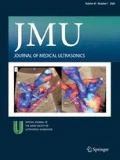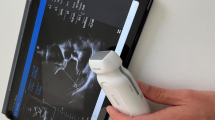Abstract
The number of patients with heart failure has been dramatically increasing in Japan in association with aging of the society. This phenomenon is referred to as a heart failure pandemic. The fundamental origin of heart failure is cardiac dysfunction. Echocardiography is widely used to assess cardiac function, as well as to diagnose heart diseases that cause cardiac dysfunction. However, the severity of heart failure is not necessarily correlated with that of cardiac dysfunction. This is partly explained by the fact that heart failure induces dysfunction of organs other than the heart through hemodynamic deterioration and neurohumoral changes. In addition, one of the characteristics of patients with heart failure, particularly elderly patients, is the presence of numerous comorbidities. Symptoms of heart failure are not specific, and assessment of cardiac function, particularly left ventricular diastolic function, has not been established. Thus, ultrasonographic assessment of organs other than the heart helps the diagnosis of heart failure, assessment of the severity of heart failure, and development of our understanding of the pathophysiology in each patient. This review summarizes current knowledge about the usefulness of ultrasonographic assessment of organs other than the heart in heart failure.


Permission from [46]

Permission from [47]

Permission from Ref. [18]

Permission from Ref. [26]

Reproduced from data of Ref. [33]

Permission from Ref. [34]


Permission from Ref. [45]
Similar content being viewed by others
References
Smiseth OA. Evaluation of left ventricular diastolic function: state of the art after 35 years with Doppler assessment. J Echocardiogr. 2018;16:55–64.
Yamamoto K, Nishimura RA, Chaliki HP, et al. Determination of left ventricular filling pressure by Doppler echocardiography in patients with coronary artery disease: critical role of left ventricular systolic function. J Am Coll Cardiol. 1997;30:1819–26.
Yamada S, Iwano H, Ohte H, et al. Limitation of echocardiographic indexes for the accurate estimation of left ventricular relaxation and filling pressure: interim results of SMAP, a multicenter study in Japan (in Japanese). Jpn J Med Ultrason. 2012;39:449–56.
Chakko S, Woska D, Martinez H, et al. Clinical, radiographic, and hemodynamic correlations in chronic congestive heart failure: conflicting results may lead to inappropriate care. Am J Med. 1991;90:353–9.
Lichtenstein D, Meziere G, Biderman P, et al. The comet-tail artifact. An ultrasound sign of alveolar-interstitial syndrome. Am J Respir Crit Care Med. 1997;156:1640–6.
Soldati G, Inchingolo R, Smargiassi A, et al. Ex vivo lung sonography: morphologic-ultrasound relationship. Ultrasound Med Biol. 2012;38:1169–79.
Picano E, Pellikka PA. Ultrasound of extravascular lung water: a new standard for pulmonary congestion. Eur Heart J. 2016;37:2097–104.
Jambrik Z, Gargani L, Adamicza A, et al. B-lines quantify the lung water content: a lung ultrasound versus lung gravimetry study in acute lung injury. Ultrasound Med Biol. 2010;36:2004–10.
Enghard P, Rademacher S, Nee J, et al. Simplified lung ultrasound protocol shows excellent prediction of extravascular lung water in ventilated intensive care patients. Crit Care. 2015;19:36.
Gargani L, Lionetti V, Di Cristofano C, et al. Early detection of acute lung injury uncoupled to hypoxemia in pigs using ultrasound lung comets. Crit Care Med. 2007;35:2769–74.
Suzuki K, Hirano Y, Yamada H, et al. Practical guidance for the implementation of stress echocardiography. J Echocardiogr. 2018;16:105–29.
Scali MC, Zagatina A, Ciampi Q, et al. The functional meaning of B-profile during stress lung ultrasound. JACC Cardiovasc Imaging. 2018;12:928–30.
Picano E, Scali MC, Ciampi Q, et al. Lung ultrasound for the cardiologist. JACC Cardiovasc Imaging. 2018;11:1692–705.
Hubert A, Girerd N, Le Breton H, et al. Diagnostic accuracy of lung ultrasound for identification of elevated left ventricular filling pressure. Int J Cardiol. 2019;281:62–8.
Lang RM, Badano LP, Mor-Avi V, et al. Recommendations for cardiac chamber quantification by echocardiography in adults: an update from the American Society of Echocardiography and the European Association of Cardiovascular Imaging. J Am Soc Echocardiogr. 2015;28:1–39 e14.
Magnino C, Omede P, Avenatti E, et al. Inaccuracy of right atrial pressure estimates through inferior vena cava indices. Am J Cardiol. 2017;120:1667–73.
Millonig G, Friedrich S, Adolf S, et al. Liver stiffness is directly influenced by central venous pressure. J Hepatol. 2010;52:206–10.
Taniguchi T, Sakata Y, Ohtani T, et al. Usefulness of transient elastography for noninvasive and reliable estimation of right-sided filling pressure in heart failure. Am J Cardiol. 2014;113:552–8.
Yoshitani T, Asakawa N, Sakakibara M, et al. Value of virtual touch quantification elastography for assessing liver congestion in patients with heart failure. Circ J. 2016;80:1187–95.
Taniguchi T, Ohtani T, Kioka H, et al. Liver stiffness reflecting right-sided filling pressure can predict adverse outcomes in patients with heart failure. JACC Cardiovasc Imaging. 2019;12:955–64.
Hopper I, Kemp W, Porapakkham P, et al. Impact of heart failure and changes to volume status on liver stiffness: non-invasive assessment using transient elastography. Eur J Heart Fail. 2012;14:621–7.
Lemmer A, VanWagner LB, Ganger D. Assessment of advanced liver fibrosis and the risk for hepatic decompensation in patients with congestive hepatopathy. Hepatology. 2018;68:1633–41.
Goldberg DJ, Surrey LF, Glatz AC, et al. Hepatic fibrosis is universal following Fontan operation, and severity is associated with time from surgery: a liver biopsy and hemodynamic study. J Am Heart Assoc. 2017;6:e004809.
Farr M, Mitchell J, Lippel M, et al. Combination of liver biopsy with MELD-XI scores for post-transplant outcome prediction in patients with advanced heart failure and suspected liver dysfunction. J Heart Lung Transplant. 2015;34:873–82.
Ohte N, Narita H, Sugawara M, et al. Clinical usefulness of carotid arterial wave intensity in assessing left ventricular systolic and early diastolic performance. Heart Vessels. 2003;18:107–11.
Nogami Y, Seo Y, Yamamoto M, et al. Wave intensity as a useful modality for assessing ventilation-perfusion imbalance in subclinical patients with hypertension. Heart Vessels. 2018;33:931–8.
Vriz O, Pellegrinet M, Zito C, et al. One-point carotid wave intensity predicts cardiac mortality in patients with congestive heart failure and reduced ejection fraction. Int J Cardiovasc Imaging. 2015;31:1369–78.
Iida N, Seo Y, Sai S, et al. Clinical implications of intrarenal hemodynamic evaluation by doppler ultrasonography in heart failure. JACC Heart Fail. 2016;4:674–82.
Sugiura T, Wada A. Resistive index predicts renal prognosis in chronic kidney disease. Nephrol Dial Transplant. 2009;24:2780–5.
Hanamura K, Tojo A, Kinugasa S, et al. The resistive index is a marker of renal function, pathology, prognosis, and responsiveness to steroid therapy in chronic kidney disease patients. Int J Nephrol. 2012;2012:139565.
Moghazi S, Jones E, Schroepple J, et al. Correlation of renal histopathology with sonographic findings. Kidney Int. 2005;67:1515–20.
Toda H, Nakamura K, Nakahama M, et al. Clinical characteristics of responders to treatment with tolvaptan in patients with acute decompensated heart failure: importance of preserved kidney size. J Cardiol. 2016;67:177–83.
Sugihara S, Kinugasa Y, Takata T, et al. Ultrasound assessment of kidney volume in patients with acute decompensated heart failure: a predictor of diuretic resistance. Yonago Acta Med. 2017;60:135–44.
Sandek A, Bauditz J, Swidsinski A, et al. Altered intestinal function in patients with chronic heart failure. J Am Coll Cardiol. 2007;50:1561–9.
Valentova M, von Haehling S, Bauditz J, et al. Intestinal congestion and right ventricular dysfunction: a link with appetite loss, inflammation, and cachexia in chronic heart failure. Eur Heart J. 2016;37:1684–91.
Sandek A, Swidsinski A, Schroedl W, et al. Intestinal blood flow in patients with chronic heart failure: a link with bacterial growth, gastrointestinal symptoms, and cachexia. J Am Coll Cardiol. 2014;64:1092–102.
Ikeda Y, Ishii S, Fujita T, et al. Prognostic impact of intestinal wall thickening in hospitalized patients with heart failure. Int J Cardiol. 2017;230:120–6.
Ribeiro JP, Chiappa GR, Neder JA, et al. Respiratory muscle function and exercise intolerance in heart failure. Curr Heart Fail Rep. 2009;6:95–101.
Yamada K, Kinugasa Y, Sota T, et al. Inspiratory muscle weakness is associated with exercise intolerance in patients with heart failure with preserved ejection fraction: a preliminary study. J Card Fail. 2016;22:38–47.
Chua TP, Anker SD, Harrington D, et al. Inspiratory muscle strength is a determinant of maximum oxygen consumption in chronic heart failure. Br Heart J. 1995;74:381–5.
Mangner N, Weikert B, Bowen TS, et al. Skeletal muscle alterations in chronic heart failure: differential effects on quadriceps and diaphragm. J Cachexia Sarcopenia Muscle. 2015;6:381–90.
Bowen TS, Rolim NP, Fischer T, et al. Heart failure with preserved ejection fraction induces molecular, mitochondrial, histological, and functional alterations in rat respiratory and limb skeletal muscle. Eur J Heart Fail. 2015;17:263–72.
Mead J, Loring SH. Analysis of volume displacement and length changes of the diaphragm during breathing. J Appl Physiol Respir Environ Exerc Physiol. 1982;53:750–5.
Miyagi M, Kinugasa Y, Sota T, et al. Diaphragm muscle dysfunction in patients with heart failure. J Card Fail. 2018;24:209–16.
Kinugasa Y, Miyagi M, Sota T, et al. Dynapenia and diaphragm muscle dysfunction in patients with heart failure. Eur J Prev Cardiol. 2018;25:1785–6.
Soldati G, Demi M. The use of lung ultrasound images for the differential diagnosis of pulmonary and cardiac interstitial pathology. J Ultrasound. 2017;20:91–6.
Castera L, Forns X, Alberti A. Non-invasive evaluation of liver fibrosis using transient elastography. J Hepatol. 2008;48:835–47.
Acknowledgements
The authors are grateful to Takuya Ishisugi, MS, and Mari Miyagi, MS, for their assistance.
Funding
This work was supported by JSPS KAKENHI Grant numbers 16K09435, 17K00855, 18K10671, and 19K08582, and the Japan Heart Foundation (Tokyo, Japan).
Author information
Authors and Affiliations
Corresponding author
Ethics declarations
Conflict of interest
The authors have no relationships relevant to the contents of this paper to disclose.
Ethical statements
All the procedures followed were in accordance with the Helsinki Declaration of 1964 and later versions.
Additional information
Publisher's Note
Springer Nature remains neutral with regard to jurisdictional claims in published maps and institutional affiliations.
About this article
Cite this article
Yamamoto, K., Kinugasa, Y., Sugihara, S. et al. Ultrasonographic assessment of organs other than the heart in patients with heart failure. J Med Ultrasonics 46, 389–397 (2019). https://doi.org/10.1007/s10396-019-00953-3
Received:
Accepted:
Published:
Issue Date:
DOI: https://doi.org/10.1007/s10396-019-00953-3




